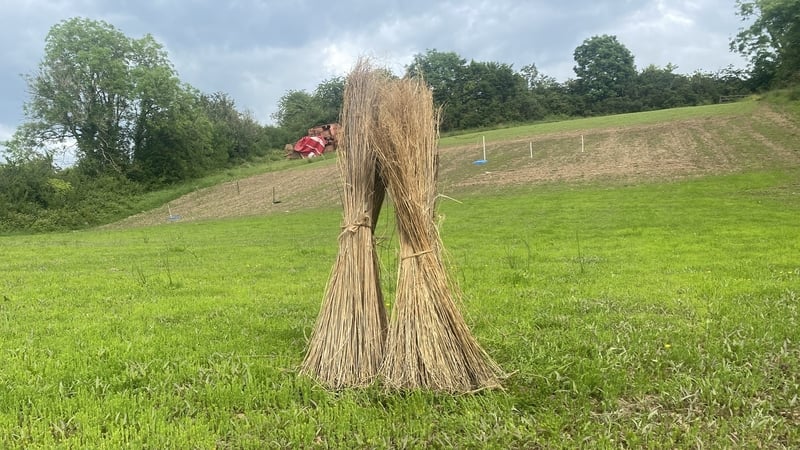

Once celebrated as “Linenopolis,” Belfast was at the heart of a global linen empire. In the 19th century, flax spinning and weaving shaped the city’s identity and economy, employing nearly 40% of Northern Ireland’s population.
Today, a wave of innovators, farmers, designers, and engineers are breathing new life into Ireland’s long-dormant flax industry—with an eye firmly on sustainability, circularity, and modern design.
From Fabric to Future: New Uses for Ancient Fibres
While flax was once mainly used to produce linen garments, its fibres are now finding new purpose in everything from surfboards and skateboards to car interiors, aircraft trays, and acoustic equipment. These natural fibres are being embraced as biodegradable, eco-friendly alternatives to fibreglass and carbon fibre.
This innovation is being spearheaded by a research project backed by Invest Northern Ireland. Leading the charge is Professor Jane McCann, who has spent over five years studying flax composites. She explains that flax, when combined with resin, forms durable materials strong enough for high-performance products like tennis rackets and dashboards.
“There’s enormous potential in replacing plastics,” McCann says. “The challenge now lies in developing fully eco-friendly resins. The best options, like sugar-based bio-resins, still have limitations—such as their dark coloration that hides weaves and surface details.”
Reconnecting with Roots Through Design
At the Ulster University Belfast School of Art, flax is not just a material—it’s a statement. Professor Alison Gault is leading a rooftop design project that incorporates flax-based tiles into a new roof garden six floors above the city. Made from a mix of wool, hemp, flax, and partially bio-based resin, the tiles will be tested against the elements.
“This isn’t just about sustainability. It’s about reconnection,” Gault says. “Just as we’ve become distanced from where our food comes from, we’ve lost touch with where our fabrics originate. This project is a small but powerful way to reignite that relationship.”
The Belfast School of Art has deep ties to the textile world. For Gault, the work is personal—her grandmother once worked in the linen mills of Belfast. “I chose textiles,” she notes. “My grandmother didn’t have that choice. She and thousands like her endured harsh conditions in the mills. Now, we can reimagine this legacy in ways that are ethical, innovative, and sustainable.”
From Tyrone Soil to Hollywood Sets
In County Tyrone, Mallon Linen has transformed an old dairy farm into a thriving flax field. Charlie Mallon and his partner Helen plant flax each May, harvesting it 100 days later after a stunning July bloom of blue flowers—a traditional symbol of Ulster.
Using a vintage 1940s machine, Mallon hand-processes the flax through a labour-intensive retting and scutching process. “We use an old cheese vat to wet the fibres,” he says. “It’s all about preserving the integrity of the plant.”
Mallon’s flax has already made its way to Hollywood, having been used for costumes, props, and wigs in the recent live-action production of How to Train Your Dragon, filmed across Northern Ireland. It’s also being trialled in fashion, with designers incorporating it into faux fur and outerwear.
Bringing Back the Mills—With a Modern Twist
Despite the renewed interest, one critical gap remains: spinning. There are currently no working flax spinning mills in either Ireland or the UK. But that, too, is changing.
Mario Sierra, creative director of Mourne Textiles in County Down, is leading a revival effort to restore five vintage spinning machines. Found abandoned and rusting, these machines are being rebuilt—some from scratch—through crowdfunding and community engagement.
“Our aim isn’t to create a museum,” Sierra insists. “This will be a working flax mill—accessible to Irish flax growers. The skills still exist, and we’re working with former mill workers who remember exactly how these machines operated.”
This restoration project was recently featured at the Future Observatory: Tomorrow’s Wardrobe exhibition at London’s Design Museum.
A Nationwide Revival: Local, Regenerative, and Collaborative
Beyond Tyrone and Belfast, small-scale flax cultivation is underway across counties Cork, Wicklow, Galway, Cavan, and Antrim—often for educational or tourism purposes. Fibreshed Ireland, a social enterprise dedicated to natural fibre systems, is tracking these initiatives on an interactive map.
Co-founder Malú Colorín stresses that the flax revival isn’t about returning to the industrial past. “We’re building a decentralised network of small and mid-scale farmers, processors, and makers. We’re prioritising regenerative practices over profit margins,” she says. “The old model collapsed because it scaled up too fast and depended too heavily on volatile demand—like during World War I. When the war ended, so did the jobs.”
The Road Ahead: Crafting a Sustainable Future from Irish Soil
From furniture design to fashion, aircraft interiors to film sets, Irish-grown flax is being woven into a new economic and cultural tapestry. This time, it’s not about mass production—it’s about community, craftsmanship, and conscious growth.
As Charlie Mallon reflects, “We’re trying to bring this industry back—not to what it was, but to what it could be: smaller, sustainable, and rooted in the land.”
And in doing so, Ireland may once again clothe the world—not just in linen, but in legacy.



